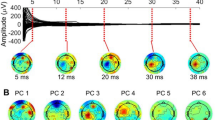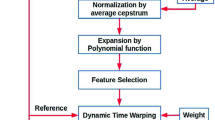Abstract
Separation of blind source signals from a mixture remains an open issue. Many algorithms have been proposed for blind source separation (BSS) in the literature, but none outperforms the other. Most of the earlier BSS methods were based on the assumption that the sources are independent and non-Gaussian. From the literature, it is observed that speech signals are modelled using Gaussian models. This work focuses on a new approach for BSS in speech processing applications by considering the second-order statistics of the speech signals based on a canonical correlation approach. The performance of the algorithm is analyzed using signal-to-interference ratio, signal-to-distortion ratio, signal-to-artifact ratio and signal-to-noise ratio. Simulation results highlight the better performance of the proposed method as compared to the state of the art approaches like principal component analysis, singular value decomposition and independent component analysis algorithms.










Similar content being viewed by others
References
F. Aires, W.B. Rossow, A. Chédin, Rotation of EOFs by the independent component analysis: toward a solution of the mixing problem in the decomposition of geophysical time series. J. Atmos. Sci. 72(9), 111–123 (2002)
J. Antoni, Blind separation of vibration component: principles and demonstrations. Mech. Syst. Signal Process. 19(6), 1166–1180 (2005)
D. Barroso, P. Ripollés, J.M. Pallarés, B. Mohammadi, T.F. Münte, A.C. Bachoud-Lévi, A. Rodriguez-Fornells, R. Diego-Balaguer, Multiple brain networks underpinning word learning from fluent speech revealed by independent component analysis. NeuroImage 110, 182–193 (2015)
A. Belouchrani, G. Moeness, Blind source separation based on time-frequency signal representations. IEEE Trans. Signal Process. 46(11), 2888–2897 (1998)
R. Chai, G.R. Naik, T.N. Nguyen, S.H. Ling, Y. Tran, A. Craig, H. Nguyen, Driver fatigue classification with independent component by entropy rate bound minimization analysis in an EEG-based system. IEEE J. Biomed. Health Inf. (2016). doi:10.1109/JBHI.2016.2532354
P. Comon, C. Jutten, J. Herault, Blind separation of sources. Part II: problem statement. Signal Process. 24(1), 11–20 (1991)
Y. Deville, Towards industrial applications of blind source separation and independent component analysis. Laboratorie d’ Acoustic, de Metrologie, d’ Instrumentation (LAMI) (Universite paul sabtier, France)
D. Erdogmus, E.K. Hild, C. J. Principe, L. Vielva, Blind separation of uncorrelated sources via principal component analysis of observations for a symmetric mixing matrix, in \(11{{th}}\) European Signal Processing Conference, pp. 1–4 (2002)
C. Ghita, R. Doru Raichu, B. Pantelimon, Implementation of the fast ICA algorithm in sound source separation, in \(9{{th}}\) International Symposium on Advanced Topics in Electrical Engineering (ATEE), pp. 19–22 (2015)
J. Guo, Y. Deng, A Time-Frequency Algorithm for Noisy ICA. Geo-Informatics Resource Management and Sustainable Ecosystem (Springer, Berlin, 2015)
Y. Guo, G.R. Naik, H. Nguyen, Single channel blind source separation based local mean decomposition for biomedical applications, in \(35{{th}}\) Annual International Conference of the IEEE Engineering in Medicine and Biology Society (EMBC), pp. 6812–6815 (2013)
Y. Guo, S. Huang, Y. Li, G.R. Naik, Edge effect elimination in single-mixture blind source separation. Circuits Syst. Signal Process. 32(5), 2317–2334 (2013)
S. Haykin, Unsupervised Adaptive Filtering, vol 1 (Newyork, Chichester, Weinheim, Brisbane, Singapore, Toronto, 2000)
M.G. Jafari, W. Wang, J.A. Chambers, T. Hoya, A. Cichocki, Sequential blind source separation based exclusively on second order statistics developed for a class of periodic signals. IEEE Trans. Signal Process. 54(3), 1028–1040 (2006)
K. Juha, T. Hao, J. Ylipaavalniemi, A generalized canonical correlation analysis based method for blind source separation from related data sets, in the 2012 International Joint Conference on Neural Networks (IJCNN). IEEE (2012)
G. Kerschen, F. Poncelet, J.C. Golinval, Physical interpretation of independent component analysis in structural dynamics. Mech. Syst. Signal Process. 21(4), 1561–1575 (2007)
C.T. Le, S. Moghaddamnia, C. Kupferschmidt, T. Kaiser, Performance evaluation blind source separation algorithms base on source signal statistics in convolutive mixtures, in International Conference on Communications and Electronics, pp. 268–272 (2010)
Z. Li, J. An, L. Sun, M. Yang, A blind source separation algorithm based on whitening and non-linear decorrelation, in Second International Conference on Computer Modelling and Simulation, vol 1, pp. 443–447 (2010)
X. Lin Li, T. Adali, Independent component analysis by entropy bound minimisation. IEEE Trans. Signal Process. 58(10), 5151–5164 (2010)
A. Mansour, A. A-Falou, Performance indices for real-world applications, in \(14{{th}}\) European Signal Processing Conference, pp. 1–5 (2006)
G.R. Naik, K.D. Kumar, Estimation of independent and dependent components of non-invasive EMG using fast ICA: validation in recognising complex gestures. Comput. Methods Biomech. Biomed. Eng. 14(12), 1105–1111 (2011)
G.R. Naik, K.D. Kumar, M. Palaniswami, Signal processing evaluation of myoelectric sensor placement in low-level gestures: sensitivity analysis using independent component analysis. Expert Syst. l.31(1), 91–99 (2012)
G.R. Naik, A.H. Al-Timemy, H.T. Nguyen, Transradial amputee gesture classification using an optimal number of sEMG sensors: an approach using ICA clustering. IEEE Trans. Neural Syst. Rehabil. Eng. 24(8), 837–846 (2016)
G.R. Naik, S.E. Selvan, H.T. Nguyen, Single-channel EMG classification with ensemble-empirical-mode-decomposition-based ICA for diagnosing neuromuscular disorders. IEEE Trans. Neural Syst. Rehabil. Eng. 24(7), 734–743 (2016)
R. Okamoto, S. Bando, A. Nozawa, Blind signal processing of facial thermal images based on independent component analysis. IEE J. Trans. Electron. Inf. Syst. 136(8), 1142–1148 (2016)
G. Pendharkar, G.R. Naik, H.T. Nguyen, Using blind source separation on accelerometry data to analyze and distinguish the toe walking gait from normal gait in ITW children. Biomed. Signal Process. Control 13, 41–49 (2014)
D. Persia, E. Leandro, D.H. Milone, Using multiple frequency bins for stabilization of FD-ICA algorithms. Signal Process. 119, 162–168 (2015)
M. Plumbly, Algorithm for nonnegative independent component analysis. IEEE Trans. Neural Netw. 14(3), 534–543 (2003)
V.G. Reju, S.N. Koh, I.Y. Soon, An algorithm for mixing matrix estimation in instantaneous source separation. Signal Process. 89(9), 1762–1773 (2009)
B. Rivert, L. Girin, C. Jutten, Mixing audio–visual speech processing and blind source separation for the extraction of speech signals from convolutive mixtures. IEEE Trans. Audio Speech Lang. Process. 15(1), 96–108 (2006)
T. Shijiea, C. Hang, Blind source separation of underwater acoustic signal by use of negentropy-based fast ICA algorithm, in IEEE International Conference on Computational Intelligence & Communication Technology, pp. 608–611 (2015)
P.M. Syskind, W. DeLiang, J. Larsen, U. Kjems, Two-microphone separation of speech mixtures. IEEE Trans. Neural Netw. 19(3), 475–492 (2008)
E. Vincent, R. Gribonval, C. Févotte, Performance measurement in blind audio source separation. IEEE Trans. Audio Speech Lang. Process. 14(4), 1462–1469 (2006)
J. Wang, C. Chang, Independent component analysis based dimensionality reduction with applications in hyper-spectral image analysis. IEEE Trans. Geosci. Remote Sens. 44(6), 1586–1600 (2006)
Y. Wu, T.T. Guo, B. Zhang, L. Guo, J. Wu, L. Zhao, Applications of blind source separation in ultrasonic NDE, in Second International Workshop on Education Technology and Computer Science, vol 3, pp. 115–118 (2010)
W. Ying, G. Tian-tai, J. Jie-wei, Applications of blind sources separation in plant leaves classification, in \(10{{th}}\) World Congress on Intelligent Control and Automation, pp. 4174–4179 (2012)
L. Zou, X. Chen, Z. Jane, Underdetermined joint blind source separation for two datasets based on tensor decomposition. IEEE Signal Process. 23(5), 673–677 (2016)
Author information
Authors and Affiliations
Corresponding author
Rights and permissions
About this article
Cite this article
Anil Kumar, V., Rama Rao, C.V. & Dutta, A. Performance Analysis of Blind Source Separation Using Canonical Correlation. Circuits Syst Signal Process 37, 658–673 (2018). https://doi.org/10.1007/s00034-017-0566-x
Received:
Revised:
Accepted:
Published:
Issue Date:
DOI: https://doi.org/10.1007/s00034-017-0566-x




